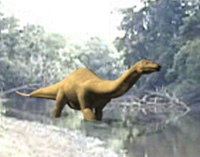Mokele-mbembe

Mokele-mbembe is a terrifying lake monster alleged to be an inhabitant of the swamps in the Republic of the Congo, or perhaps swamps throughout central Africa. Its name has been translated as “one that stops the flow of rivers.”1,2 Over a span of more than 200 years, descriptions of Mokele-mbembe have frequently been similar among Pygmy peoples and cryptozoologists, yet there is no recognized physical evidence of its existence, such as fossils, carcass remains and bones. Any purported photos and film are controversial.
Mokele-mbembe is usually described as a four-legged hairless creature the size of an elephant or hippopotamus, with smooth reddish-brown or brownish-gray skin, a neck estimated to be between 5 and 10 feet long, a long and strong tail of the same length said to be similar to an alligator’s, three claws on its feet, and a horn-like protuberance on its head. Some reports include a description of a “frill” similar to a cock’s comb on its head. Reputed tracks are rounded, up to 3 feet in diameter, and indicate a stride of 7-8 feet.3
Some cryptozoologists have compared its shape to a sauropod, a reptilian dinosaur.3,4,5 Mokele-mbembe is an herbivore that leaves the water only long enough to obtain food from nearby vegetation.2,4 It reportedly kills the occupants of boats and canoes and attacks humans who get too close to it, but does not eat them.
Mokele-mbembe is referred to in the present tense because there continue to be expeditions to the area by cryptozoologists hoping to obtain proof of its existence.
The first reported sighting of huge unexplained footprints by a French missionary in the Congo River region was in 1776, and there have been more than 25 expeditions to the area between 1909 and 2006, including one in 1919 sponsored by the Smithsonian Institution.2
University of Chicago professor Roy Mackal, a well-known cryptozoologist, relayed a story told to him in 1981 during an expedition: Congo natives had once built a barrier of stakes across a river to keep Mokele-mbembe from disrupting their fishing. When the monster was slowed by the stakes, the villagers killed it with their spears, cooked it, and had a celebratory feast. According to the tale, everyone who partook died soon afterwards.6
While on an expedition in 1983, a Congolese biologist claimed to have seen Mokele-mbembe for a full 20 minutes himself. He filmed it with his movie camera but inadvertently left the lens cap on.6
In 1992, a Japanese film crew shooting a documentary from a small plane saw a large creature swimming through a lake, leaving a wake. The cameraman zoomed in and captured about 15 seconds of the moving shape. The resulting film footage is jerky and blurred, therefore inconclusive. Skeptics say the film shows not a lake monster but two men paddling a canoe, admittedly at a near impossible rate of speed.6
There are valid arguments on both sides of the puzzle of Mokele-mbembe’s existence and many unanswered questions. It is possible that it’s a previously undiscovered reptile or dinosaur, or just a fantastic legend passed along like a folk tale. The mystery parallels the ongoing Bigfoot debate.
2.http://en.wikipedia.org/wiki/Mokele-mbembe
3.http://www.mokelembembe.com
4.http://www.angelfire.com/pq/cryptozoologix/mokelembembe.html
5.http://skepdic.com/mokele.html
6.http://www.angelfire.com/pq/cryptozoologix/mokelembembe.html
